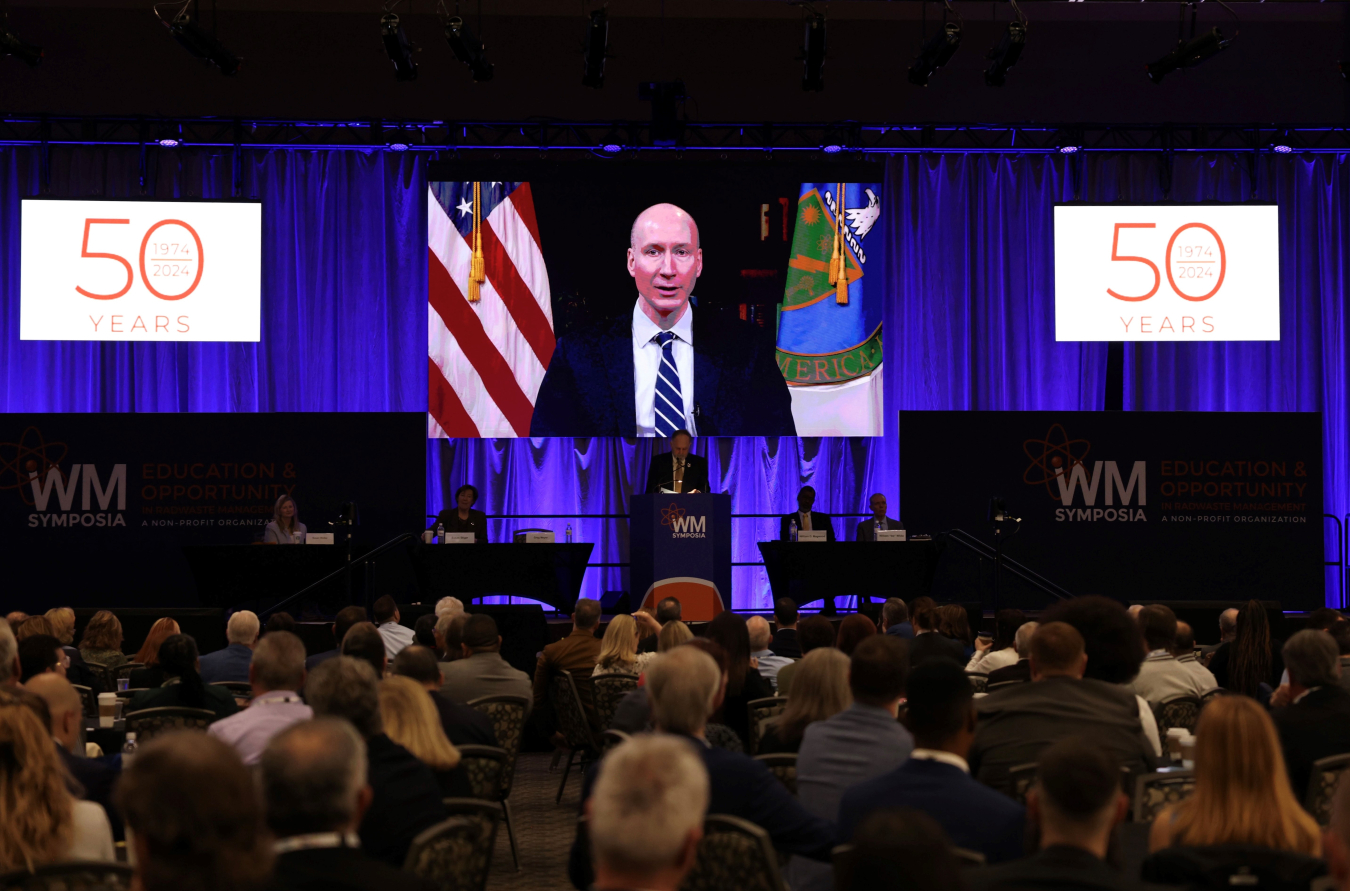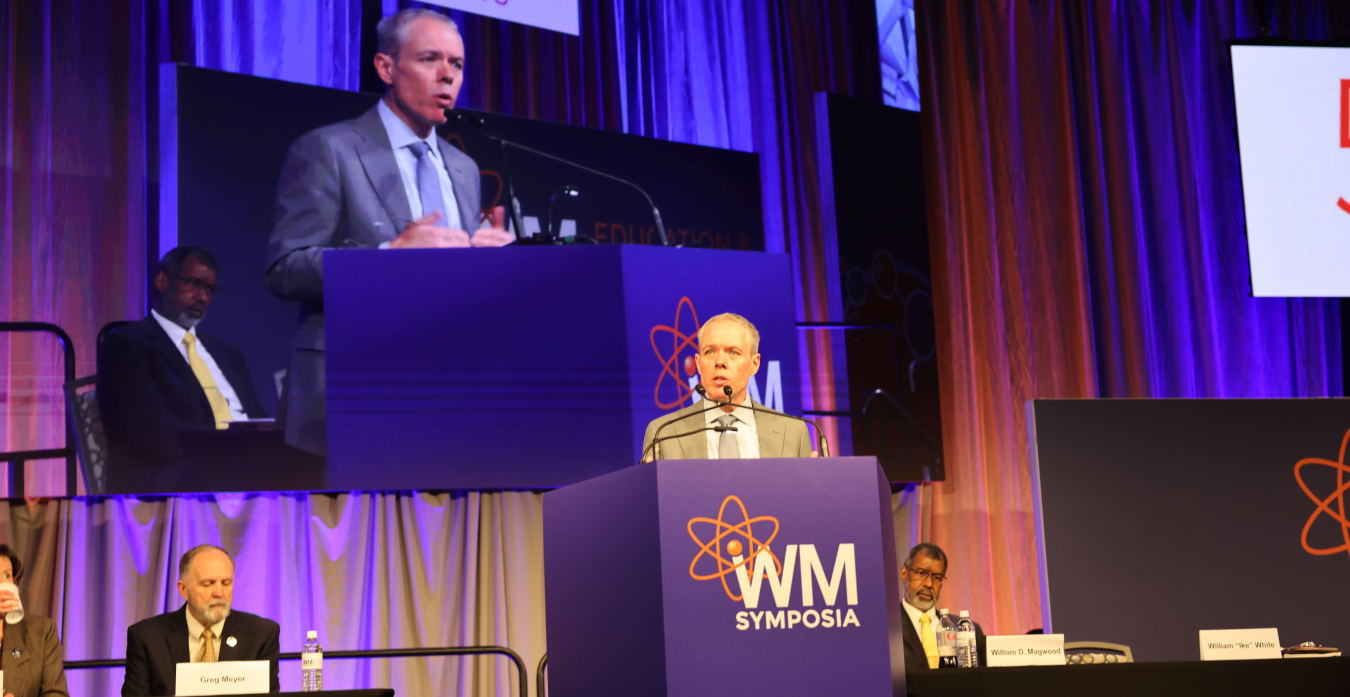In the half century since the inception of the Waste Management Symposia, many EM sites have come full circle, cleaned and transformed into wildlife refuges, wetland preserves and national parks, U.S. Deputy Energy Secretary David Turk remarked in a prerecorded video message to the audience at the annual conference.
Office of Environmental Management
March 12, 2024
PHOENIX — In the half century since the inception of the Waste Management Symposia, many EM sites have come full circle, cleaned and transformed into wildlife refuges, wetland preserves and national parks, U.S. Deputy Energy Secretary David Turk remarked Monday in a prerecorded video message to the audience at the annual conference.
“And now, together with our community partners, we’re looking even further into the future,” Turk said. “We’re exploring how our sites could become new hubs of economic development — with an eye towards national security, clean energy and innovation.”
Turk and EM Senior Advisor William “Ike” White shared remarks with conference-goers during their first full day at the event as Waste Management Symposia marks its 50th anniversary this year.
There were 200 participants in the inaugural conference in 1974, a stark contrast to the more than 3,300 attendees from 29 countries at this year’s symposium — a record attendance for the event.
In their addresses, the DOE officials noted significant cleanup achievements from 2023 — another banner year for EM — such as the treatment of billions of gallons of contaminated groundwater.
And they also painted a picture of the cleanup program’s vast progress reshaping sites over the past decades. For example, as White noted, the Fernald Site in Ohio was still turning out uranium products during the first Waste Management conference in 1974. But after dismantling 323 buildings, excavating and shipping 1 million tons of waste and treating a 225-acre plume of contamination, the site is now home to one of the largest manmade wetlands in Ohio.
Although cleanup will continue in the years ahead, EM progress has opened opportunities for clean energy development, national security priorities, scientific research and economic growth.
"While we have decades of cleanup to come at some sites, because of our workers, because of this team, the cleanup mission has now matured to the point where we can dream big about the future," Turk said. “We can dream big about all the ways these sites can once again be put to work for the American people, and people around the world.”
Turk then turned his attention to the students and early career professionals in the audience.
“You are entering this workforce at a unique time. We will need your expertise, your perspectives and ideas to help us bring these big dreams to life," he said. "So I urge you to take full advantage of this week. Talk to panelists, talk to your peers, come talk to DOE about what your career could look like in this space. We can’t wait to have you in our ranks."

Echoing Turk’s sentiment, White noted that the catchphrase, “Proud of our Past, Poised for the Future,” is as fitting for EM as it is for the 50th anniversary of Waste Management.
In his address, White discussed EM’s Strategic Vision 2024-2034, newly updated just in time for the conference, where the inaugural document debuted in 2020.
"As we approach the halfway point of the decade that was laid out in the vision document, we have delivered on the priorities that were outlined in the plan," White said.
"Game-changing tank waste treatment capabilities are now in place to address EM’s largest environmental liability," White said. "With the startup of the Salt Waste Processing Facility, a full suite of tank waste treatment capabilities is in place at Savannah River, treating nearly 6 million gallons of waste per year."
The head of EM listed numerous other accomplishments across the EM complex, illustrating the fact that the cleanup program is no longer mapping out the road to cleanup.
"EM and our industry partners are safely executing cleanup, fulfilling obligations and continuing a steady beat of progress with a shift to long term operations," he said.
Looking to the future, White emphasized EM’s need for thousands of operators, rad techs, electricians, project controls analysts, managers, mechanics and planners over the next five years alone. In conjunction with the Energy Facility Contractors Group, EM compiled projections for workforce needs across cleanup sites.
“With greater knowledge of the jobs and skills that we need, we also have an opportunity to do more to help shape workforce development to be able to meet those needs,” he said. “The projections we have hopefully will be instrumental as we partner with local communities where workforce development often begins.”
The talent pool at the Waste Management conference, though, is always impressive, White said. He noted the job fair at the symposium and added that EM is hiring.
In closing, White told the audience that EM would not be where it is today without its dedicated federal workforce, industry partners, state and other government regulators, community and tribal partners, and international partners — as well as the early career professionals who will carry on the tradition of Waste Management and will be the leaders of the cleanup program for decades to come.
"From the very first Waste Management Symposium in 1974 to today, you played key roles in getting to this point where we’re making steady progress, preparing for the future," he said. "Our collective attention to that progress, as well as broader priorities, will be important as we look to the next 50 years and beyond."
-Contributors: Matt Roberts, David Sheeley
To receive the latest news and updates about the Office of Environment Management, submit your e-mail address.

